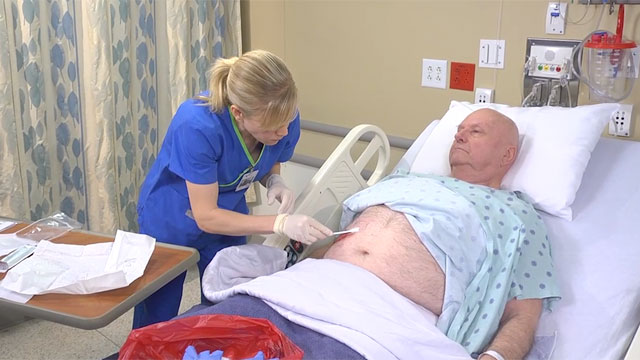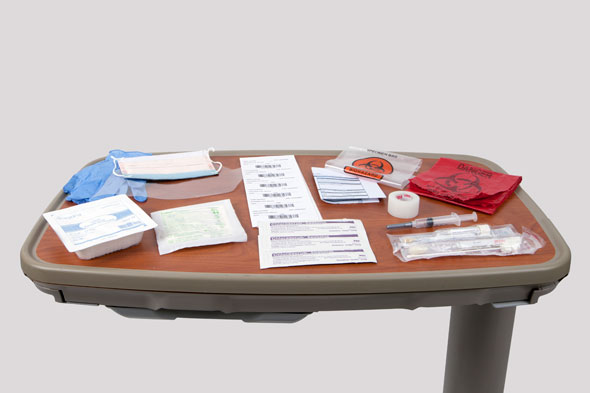Specimen Collection
Select a Skill:
- » Collecting a Midstream Urine Specimen
- » Performing Fecal Occult Blood Testing
- » Performing Gastric Occult Blood Testing
- » Collecting a Sputum Specimen
- » Collecting a Specimen for Wound Culture
- » Performing Blood Glucose Testing
- » Screening Urine for Chemical Properties
Take the Review Test:

Safety
- Deliver specimens to the laboratory within the recommended time, or ensure that they are stored properly for later transport.
- Know your agency’s policy regarding infection control practices for the transport of all specimen containers containing body substances.
- Be alert for localized inflammation, tenderness, and warmth at a wound site with purulent drainage, indicating that the wound has become infected.
- Observe for redness and bleeding around the edges of a wound, which may indicate wound trauma.
- Instruct the patient to inform you if the procedure causes pain. Stop if the patient is unable to tolerate the pain.
Equipment
(Roll cursor over items to see labels)

Culture tube with swab and transport medium for aerobic culture
Anaerobic culture tube with swab
5- to 10-mL syringe
Clean gloves
Sterile gloves
Protective eyewear (optional)
Antiseptic swabstik
Sterile gauze 4x4 dressing
Tape
Specimen biohazard bag
Specimen identification labels
Laboratory requisition form
Small plastic biohazard bag
Delegation
The skill of obtaining a wound drainage specimen may not be delegated to nursing assistive personnel (NAP). Be sure, however, to inform NAP of the following:
- Advise NAP to report to you any foul odor, increase in drainage, increase in body temperature, or complaint of discomfort by the patient.
Preparation
- Assess the patient’s understanding of the need for a wound culture and his or her ability to cooperate with the procedure.
- Assess the patient for fever, chills, and excessive thirst. Check laboratory results to see if the patient’s white blood cell (WBC) count is elevated.
- Ask the patient to report the extent and type of pain at the wound site, using a scale of 0 to 10. If the patient requires an analgesic before dressing changes, wait 30 minutes before beginning the procedure so that the medication can begin to take effect.
- Determine when the dressing change is scheduled. Perform the wound assessment as part of that procedure.
- Review the health care provider’s orders for an aerobic or an anaerobic culture.
- Apply clean gloves, and remove any soiled wound dressings. Apply sterile gloves to palpate the wound gently, noting any tenderness or drainage, inflammation, or separation at the wound edges.
Follow-up
- Obtain the laboratory report to review the results of any cultures.
- Observe the character of the wound drainage.
- Observe the edges of the wound for redness and bleeding.
- Ask the patient about the purpose of a wound culture.
Documentation
- Record the types of specimens obtained, the source, and the time and date sent to the laboratory.
- Describe the appearance of the wound and the characteristics of any drainage.
- Report any evidence of infection to the charge nurse and the health care provider.
- Record the patient’s tolerance of the procedure and response to any analgesics provided.
Review Questions
1. The health care provider writes an order for a culture specimen to be collected from a patient with a dog bite wound. What would the nurse do first?
 Explain the purpose of the test to the patient.
Explain the purpose of the test to the patient.  Assess the level of the patient’s pain at the wound site.
Assess the level of the patient’s pain at the wound site.  Assess the patient for signs and symptoms of infection.
Assess the patient for signs and symptoms of infection. Review the order to determine the type of specimen to be collected.
Review the order to determine the type of specimen to be collected.
2. Which action would the nurse take to reduce the risk for wound infection when collecting a specimen for culture?
 Collect the specimen while wearing sterile gloves.
Collect the specimen while wearing sterile gloves. Collect the specimen after washing the wound with sterile water.
Collect the specimen after washing the wound with sterile water. Collect the specimen before cleansing the wound.
Collect the specimen before cleansing the wound. Collect the specimen after administering prescribed pain medication.
Collect the specimen after administering prescribed pain medication.
3. Which question might the nurse ask the patient when an aerobic wound culture has been ordered?
 “Do you have any pain at the wound site?”
“Do you have any pain at the wound site?” “Have you ever collected a specimen from your wound before?”
“Have you ever collected a specimen from your wound before?” “Have you had any trouble breathing?”
“Have you had any trouble breathing?”  “Have your blood counts been high recently?”
“Have your blood counts been high recently?”
4. Which instruction might the nurse give to the NAP to help ensure that a wound culture specimen will be transported properly?
 “Wear sterile gloves when holding the specimen.”
“Wear sterile gloves when holding the specimen.”  “Take this specimen to the lab immediately.”
“Take this specimen to the lab immediately.”  “Borrow a specimen collection kit from another unit if we’re out of them.”
“Borrow a specimen collection kit from another unit if we’re out of them.”  “Keep the specimen tube horizontal.”
“Keep the specimen tube horizontal.”
5. Which nursing action demonstrates proper procedure in the collection of a wound culture specimen?
 Wearing clean gloves to remove soiled dressings
Wearing clean gloves to remove soiled dressings  Using a circular motion to cleanse the wound before collecting the specimen
Using a circular motion to cleanse the wound before collecting the specimen  Completing the lab requisition form in a timely manner after collecting the specimen
Completing the lab requisition form in a timely manner after collecting the specimen  Sending the specimen to the lab within 30 minutes of collecting it
Sending the specimen to the lab within 30 minutes of collecting it
You have completed the Review Questions for this skill. To take the Review again select the Start Over button. To proceed to another skill select from the dropdown menu. Select the Home or Back button to proceed to the next section.

